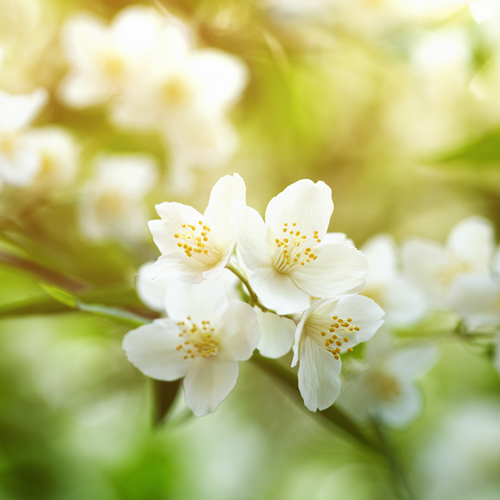
Jasmine
Scientific names: Jasminum grandiflorum, Jasminum officinale
Family: Oleaceae
Alternate names: Catalonina Jasmine, Common Jasmine, Italian Jasmine, Jasmin, Jasmin Blanc, Jasmin Commun, Jasmin d'Espagne, Jasmin à Grandes Fleurs, Jasmin Officinal, Jasmin Royal, Jati, Jazmín, Jazmín Silvestre, Poet's Jessamine, Royal Jasmine, Spanish Jasmine
Actions: Analgesic, Angiotensin-converting enzyme inhibitory, Antibacterial, Anticancer, Antidiarrheal, Antifungal activity, Anti-inflammatory, Antimutagenic, Antioxidant, Antiparasitic, Antiulcer, Autonomic nervous system, Behavioral, Cardiovascular, Dermatological, Diuretic, Hepatoprotective, Hypocholesterolemic, Mood, N-nitrosation inhibitory, Oviposition, Red blood cell protection, Sleep, Smooth muscle, Spasmolytic, Stroke prevention, Vasodilatory, Wound-healing
Background
Jasmine is a plant. The flower is used to make medicine.
Jasmine has been used for liver disease (hepatitis), pain due to liver scarring (cirrhosis), and abdominal pain due to severe diarrhea (dysentery). It is also used to prevent stroke, to cause relaxation (as a sedative), to heighten sexual desire (as an aphrodisiac), and in cancer treatment.
Jasmine is used on the skin to reduce the amount of breast milk, for skin diseases, and to speed up wound healing.
Jasmine is inhaled to improve mood, reduce stress, and reduce food cravings.
In foods, jasmine is used to flavor beverages, frozen dairy desserts, candy, baked goods, gelatins, and puddings.
In manufacturing, jasmine is used to add fragrance to creams, lotions, and perfumes.
Don't confuse jasmine with plants known as gardenia or gelsemium.
Jasmine has been used for liver disease (hepatitis), pain due to liver scarring (cirrhosis), and abdominal pain due to severe diarrhea (dysentery). It is also used to prevent stroke, to cause relaxation (as a sedative), to heighten sexual desire (as an aphrodisiac), and in cancer treatment.
Jasmine is used on the skin to reduce the amount of breast milk, for skin diseases, and to speed up wound healing.
Jasmine is inhaled to improve mood, reduce stress, and reduce food cravings.
In foods, jasmine is used to flavor beverages, frozen dairy desserts, candy, baked goods, gelatins, and puddings.
In manufacturing, jasmine is used to add fragrance to creams, lotions, and perfumes.
Don't confuse jasmine with plants known as gardenia or gelsemium.
Safety Safety definitions
When taken by mouth: Jasmine is LIKELY SAFE for most people in food amounts. There isn't enough reliable information to know if jasmine is safe when taken by mouth as a medicine.
When applied to the skin: There isn't enough reliable information to know if jasmine is safe when applied to the skin as a medicine. Jasmine might cause allergic reactions in some people.
When applied to the skin: There isn't enough reliable information to know if jasmine is safe when applied to the skin as a medicine. Jasmine might cause allergic reactions in some people.
Special Precautions & Warnings:
Pregnancy and breast-feeding: There isn't enough reliable information to know if jasmine is safe to use in medicinal amounts when pregnant or breast-feeding. Stay on the safe side and stick to food amounts.Effectiveness
NatMed Pro rates effectiveness based on scientific evidence according to the following scale: Effective, Likely Effective, Possibly Effective, Possibly Ineffective, Likely Ineffective, Ineffective, and Insufficient Evidence to Rate.
Insufficient evidence Effectiveness definitions
- Mental alertness. Inhaling jasmine aroma during an alertness tests doesn't seem to improve reaction time or number of correct responses. Also, inhaling jasmine aroma during breaks between concentration tests doesn't seem to reduce mental tiredness during the later test.
- Cancer treatment.
- Increasing sexual desire (as an aphrodisiac)..
- Liver disease (hepatitis).
- Pain due to liver scarring (cirrhosis).
- Stomach pain due to severe diarrhea (dysentery).
- Skin diseases.
- To cause relaxation (as a sedative).
- Wound healing.
- Other conditions.
Dosing & administration
The appropriate dose of jasmine depends on several factors such as the user's age, health, and several other conditions. At this time there is not enough scientific information to determine an appropriate range of doses for jasmine. Keep in mind that natural products are not always necessarily safe and dosages can be important. Be sure to follow relevant directions on product labels and consult your pharmacist or physician or other healthcare professional before using.
Interactions with pharmaceuticals
It is not known if Jasmine interacts with any medicines. Before taking Jasmine, talk with your healthcare professional if you take any medications.
Interactions with herbs & supplements
There are no known interactions with herbs and supplements.
Interactions with foods
There are no known interactions with foods.
vital.ly has licensed monographs from TRC Healthcare.
This monograph was last reviewed on 12/04/2024 10:00:00 and last updated on 26/09/2014 17:16:28. Monographs are reviewed and/or updated multiple times per month and at least once per year.
Natural Medicines disclaims any responsibility related to medical consequences of using any medical product. Effort is made to ensure that the information contained in this monograph is accurate at the time it was published. Consumers and medical professionals who consult this monograph are cautioned that any medical or product related decision is the sole responsibility of the consumer and/or the health care professional. A legal License Agreement sets limitations on downloading, storing, or printing content from this Database. No reproduction of this monograph or any content from this Database is permitted without written permission from the publisher. It is unlawful to download, store, or distribute content from this site.




